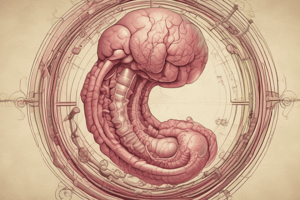Podcast
Questions and Answers
What is the primary function of the placenta?
What is the primary function of the placenta?
- Hormonal regulation
- Fetal immunity
- Nutrient and gas exchange between mother and fetus (correct)
- Waste storage
Which two components make up the placenta?
Which two components make up the placenta?
- Chorion and decidua
- Fetal tissue and maternal blood
- Maternal and fetal parts (correct)
- Uterine wall and amniotic fluid
From which layer of the uterus does the maternal part of the placenta develop?
From which layer of the uterus does the maternal part of the placenta develop?
- Endometrium (correct)
- Placental layer
- Perimetrium
- Myometrium
What develops the fetal part of the placenta?
What develops the fetal part of the placenta?
Which of the following is NOT a function attributed to the placenta?
Which of the following is NOT a function attributed to the placenta?
What results from the division of the embryonic disc in monozygotic twins?
What results from the division of the embryonic disc in monozygotic twins?
What structures are present in a case of monozygotic twins that do not have complete division?
What structures are present in a case of monozygotic twins that do not have complete division?
What is a characteristic of the embryonic disc in the development of monozygotic twins?
What is a characteristic of the embryonic disc in the development of monozygotic twins?
In which situation is it likely that monozygotic twins share the same amniotic sac?
In which situation is it likely that monozygotic twins share the same amniotic sac?
Which statement accurately describes the condition of amnion, chorion, and placenta in monozygotic twins resulting from incomplete division?
Which statement accurately describes the condition of amnion, chorion, and placenta in monozygotic twins resulting from incomplete division?
What is the primary function of the placenta in relation to the fetus?
What is the primary function of the placenta in relation to the fetus?
What substances are primarily transported from the fetal blood back to the maternal blood?
What substances are primarily transported from the fetal blood back to the maternal blood?
In what way does the placental membrane differ in its function throughout pregnancy?
In what way does the placental membrane differ in its function throughout pregnancy?
How do nutrients primarily pass from the maternal blood to the fetal blood?
How do nutrients primarily pass from the maternal blood to the fetal blood?
Which of the following best describes the role of the umbilical cord during pregnancy?
Which of the following best describes the role of the umbilical cord during pregnancy?
What maintains the circulation of amniotic fluid to and from the fetus?
What maintains the circulation of amniotic fluid to and from the fetus?
What term is synonymous with conjoint twins?
What term is synonymous with conjoint twins?
Which statement accurately describes the nature of conjoint twins?
Which statement accurately describes the nature of conjoint twins?
What does the term 'conjoint' specifically refer to in the context of twins?
What does the term 'conjoint' specifically refer to in the context of twins?
In what way do conjoint twins differ from traditional twins?
In what way do conjoint twins differ from traditional twins?
What is a common misconception about conjoint twins?
What is a common misconception about conjoint twins?
Which condition is NOT typically associated with conjoint twins?
Which condition is NOT typically associated with conjoint twins?
Which terminology describes the phenomenon of twins being joined together?
Which terminology describes the phenomenon of twins being joined together?
How are conjoint twins primarily formed?
How are conjoint twins primarily formed?
What is one example of a health concern specifically impacting conjoint twins?
What is one example of a health concern specifically impacting conjoint twins?
Which factor does NOT define the classification of conjoint twins?
Which factor does NOT define the classification of conjoint twins?
What are the layers involved in nutrient exchange within the placental villi?
What are the layers involved in nutrient exchange within the placental villi?
What is primarily responsible for the transport of waste products from the fetus to the mother via the placenta?
What is primarily responsible for the transport of waste products from the fetus to the mother via the placenta?
Which of the following best describes the maternal part of the placenta?
Which of the following best describes the maternal part of the placenta?
How does the transport of nutrients from maternal blood to fetal blood occur in the placenta?
How does the transport of nutrients from maternal blood to fetal blood occur in the placenta?
Which structure plays a critical role in the functioning of the placenta as a transport system?
Which structure plays a critical role in the functioning of the placenta as a transport system?
Flashcards are hidden until you start studying
Study Notes
Placenta
- Primary site of nutrient and gas exchange between mother and fetus.
- Fetomaternal organ that has two components:
- Fetal part from the chorionic sac
- Maternal part from the endometrium
- The placenta and umbilical cord function as a transport system for substances passing between the mother and the fetus.
- Nutrients and oxygen pass from maternal blood through the placenta to the fetal blood.
- Waste materials and carbon dioxide pass from fetal blood through the placenta to the maternal blood.
Conjoint Twins
- Also known as Siamese twins.
- Occur when the embryonic disc does not completely split or divide.
- One amnion, one chorion, and one placenta.
Monozygotic Twins
- Division of the embryonic disc results in two embryos within one amniotic sac.
- Twin transfusion syndrome can occur when there is anastomosis of the placental vessels.
- One twin may receive most of the nutrition from the placenta.
- This can lead to anemia in the donor twin and congestive heart failure in the recipient twin.
- Approximately 65% of monozygotic twins are formed from one zygote by division of the inner cell mass.
Placenta Function
- The placenta is a vital organ for fetal development.
- It serves as the primary site for nutrient and gas exchange between the mother and the fetus.
- The placenta facilitates the transport of nutrients and oxygen from the maternal blood to the fetal blood.
- Waste materials and carbon dioxide are transported from the fetal blood to the maternal blood through the placenta.
Placenta Structure
- The placenta is a fetomaternal organ, meaning it has both fetal and maternal components.
- The fetal part develops from the chorionic sac.
- The maternal part originates from the endometrium, the inner lining of the uterine wall.
Placental Villi
- The placental villi are intricate structures responsible for the exchange of nutrients and waste products.
- Maternal blood pools within spaces called lacunas, which are surrounded by layers of cells.
- These layers include the cytotrophoblast and the syncytiotrophoblast.
- Fetal blood vessels within the villi access the maternal blood supply for nutrient uptake and waste removal.
Amniotic Fluid Circulation
- Amniotic fluid is continuously circulated and exchanged between the fetus and the surrounding environment.
- The fetus swallows amniotic fluid, which is then returned to the amniotic sac.
Studying That Suits You
Use AI to generate personalized quizzes and flashcards to suit your learning preferences.




